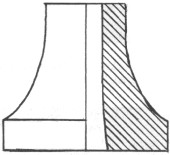Porcelain Insulator News
by Jack H. Tod, NIA #13
Reprinted from "INSULATORS - Crown Jewels of the Wire", December 1981, page 22
Dear Jack:
I have a U-293, baby-blue glaze, and with an
underglaze G-P marking (cobalt blue ink). You don't show this marking in the
second edition of your Porcelain Insulators Guide Book. Any ideas an who made
this insulator?

Are the "G" marked insulators found in any styles
other than U-11A, U-50, U-229 and U-236?

At the 1981 NIA National in Sacramento
I picked up a sleeve stand with incuse F. M. Locke marking an the base. It has a
light brown glaze with slight greenish spots. I have seen these with U-377 to
U-380 helmets in the eastern part of our state, and I matched mine up with a
U-379 with similar glaze for my collection.

I am. curious about whether this
matching in unusual? I asked a few porcelain collectors at the National about
it, and they said, "No, they were used with the larger multipart pin
types." What's correct?
Brent Burger, NIA #2657
Bellevue, Wash.
- - - - - - - - - -
Dear Brent:
On your U-293, the Monogram-CP marking is the registered trademark of Canadian
Porcelain Co. In addition to this marking, they also used several forms of
"C.P." markings on pin types. My book concerns only U.S. insulators,
so natch that marking isn't included in the book.
Regarding your "G"
insulators, these are known in styles U-11A, U-50, Sim U-55, U-229, U-236, Sim
U-250, and U-272.
What you call a "sleeve stand" is in reality the
porcelain portion of a "porcelain base pin assembly". These were a
Fred Locke creation (patent March 14, 1893), and the idea was that the
porcelain base would cure the problem of wooden pins being charred by lightning
flashover, just as it is cured by modern steel pins with only a wooden cob.
These pins were cataloged and sold an a complete assembly -- the long pin bolt,
the wooden cob at top, porcelain base part, washers and securing nut.
A
complete line of these porcelain-base pins was made, stocked and cataloged, just
an with other lines of or steel pins. There were all types and sizes --
something
that would fit any type of insulator you wanted to use, those made by Locke or
any other company. The various sizes could have been (and were) used with a multitude of insulator styles, especially styles lacking long extended interior
petticoats. Their use with helmet style insulators wouldn't have been unusual.
Porcelain-base pins were made by Locke for a number of years, and also by other
companies (most notable Illinois Electric Porcelain) after the patent expired in
1910. Their use came to a rather abrupt halt when it became general practice to
use all-steel pins for power insulators. These were much cheaper and more
reliable than wooden pins or the porcelain-base pin assemblies.
Porcelain-base
pins are not rare, but might be classed as uncommon. Early ones with Fred Locke
markings are fairly good items, but I would think the value would be best for a
complete pin assembly, not just the porcelain base portion of it.
Jack
| 